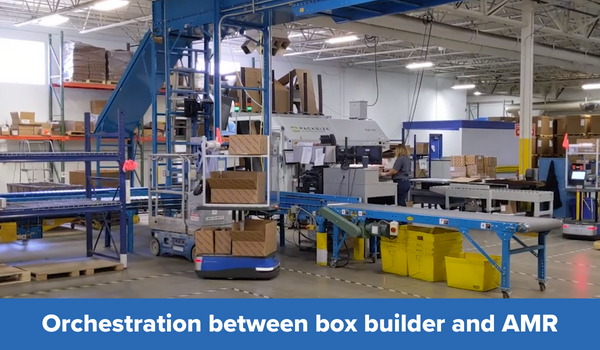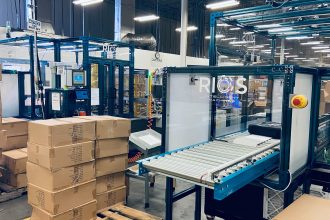Orchestrating Workflows within your Distribution Center

Supply chain logistics is going through a rapid transformation, driven by labor constraints, supply and demand uncertainty, a focus shift toward agility and responsiveness, and the introduction of associated automation technology solutions. Gone are the days where warehouses simply received, stored, picked, packed, and shipped goods with high predictability, calling for rigid infrastructure investments that could be amortized over decades. Omni-channel, personalization, postponement, pivots, returns, and labor risk mitigation with automation is the new norm within warehouses, which has changed the landscape of warehouse operations. Operations need innovative solutions to drive continuous improvement while maintaining affordable unit economics, despite the rapidly changing environment.
There is massive pressure on warehousing and distribution to find and implement a multitude of new hardware and software solutions to the warehouse. Solutions such as box builders, autobaggers, Autonomous Mobile Robots (AMR), Automated Storage and Retrieval Systems (AS/RS), Vertical Lift Modules (VLM), Goods-to-Person (GTP), Goods-to-Robot (GTR), as well as other fixed automation provide necessary improvements for a specific area of focus. While these solutions perform well in isolation, they depend on adjacent workflows (e.g., replenishment, consolidation, etc.) to obtain the designed efficiencies and often create overflows and potential bottlenecks downstream. As each area is addressed individually, the overall complexity increases and can be challenging to manage and support.
Traditional distribution centers used many layers of software to operate. Enterprise Resource Planning (ERP) or Order Management Systems (OMS) were for customer/order management. A Warehouse Management System (WMS) was used to control inventory, create tasks and track execution. And Warehouse Control Systems (WCS) managed multiple fixed automation point solutions. While this type of solution has worked well, the changes in market conditions require a higher level of orchestration than before and intelligence to ensure the best possible use of resources, proper sequencing, and prioritization of work being done.
The evolution we are seeing today in Supply Chain Logistics is similar to the evolution in manufacturing in the 70s, where Material Requirements Planning systems evolved into Manufacturing Execution Systems (MES), moving from static planning and control to dynamic information systems that drive effective execution of manufacturing operations. A hybrid approach with multiple integrated systems is often the best solution to support variable fulfillment demand.
Warehouse and Fulfillment Execution Systems (WES/FES) are moving on the same path, enabling orchestration across multiple sub-systems through real-time connectivity, leveraging AI/ML algorithms to optimize the work and maximize resource utilization intelligently. A WES/FES is software that manages, optimizes, and directs the physical work processes (picking, receiving, replenishment, etc.) in a warehouse or distribution center. A WES typically integrates with a warehouse management system (WMS), enterprise resource planning system (ERP), or other inventory management software. Intelligent orchestration via WES/FES solutions enables a holistic approach to optimization throughout the DC, allowing automated, real-time decision-making in dynamic conditions to optimize productivity with all things considered. System-directed grouping, release, and execution of work across disparate workflows with variable requirements increase the overall throughput while minimizing the potential bottlenecks downstream in the fulfillment process.
There are two basic types of WES/FES solutions; (1) products evolved from an existing Warehouse Control System (WCS). These solutions combine a WCS with work planning, release, and management capabilities, which offers the coordinated movement of product via fixed automation, and (2) solutions that are similar but orchestrate and optimize across end-to-end processes leveraging order, inventory, and task data that is internally stored, or from a host WMS. These systems extend the WCS capabilities by considering all resources and workflows, optimizing from wall to wall. The latter has given rise to new companies focused on enabling connectivity and communication across multiple automation products, easing the burden of integration within the hybrid solutions needed to overcome modern-day operational challenges.
Choosing the right WES/FES software solutions and providers to partner with will be critical to success and help drive the continuous improvement in your fulfillment operation. True optimization requires a holistic view across the entire warehouse, from receiving to shipping (wall-to-wall), facilitating multiple workflows and a phased implementation approach. Flexible and scalable automation and intelligent orchestration can be leveraged to enable system-directed work execution. This results in increased productivity, reduced labor constraints and adaptability to address changing market conditions, and increased capacity as your business grows.
To read more about the Buyer’s Journey:
Justifying Robotics In Your Operations
Robotics – The Buyer’s Journey, Part II
To learn more about The Robotics Group (TRG): https://www.mhi.org/robotics



